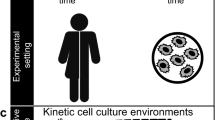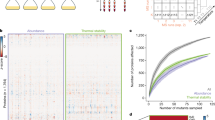Abstract
Cells adjust to changes in environmental conditions using complex regulatory programs. These cellular programs are the result of an intricate interplay between gene expression, cellular growth and protein degradation. Technologies that enable simultaneous and time-resolved measurements of these variables are necessary to dissect cellular homeostatic strategies. Here we report the development of an automated flow cytometry robotic setup that enables real-time measurement of precise and simultaneous relative growth and protein synthesis rates of multiplexed microbial populations across many conditions. These measurements generate quantitative profiles of dynamically evolving protein synthesis and degradation rates. We demonstrate this setup in the context of gene regulation of the unfolded protein response (UPR) of Saccharomyces cerevisiae and uncover a dynamic and complex landscape of gene expression, growth dynamics and proteolysis following perturbations.
This is a preview of subscription content, access via your institution
Access options
Subscribe to this journal
Receive 12 print issues and online access
$259.00 per year
only $21.58 per issue
Buy this article
- Purchase on Springer Link
- Instant access to full article PDF
Prices may be subject to local taxes which are calculated during checkout



Similar content being viewed by others
References
Zhang, Q. & Andersen, M.E. Dose response relationship in anti-stress gene regulatory networks. PLOS Comput. Biol. 3, e24 (2007).
Muzzey, D. & van Oudenaarden, A. Quantitative time-lapse fluorescence microscopy in single cells. Annu. Rev. Cell Dev. Biol. 25, 301–327 (2009).
Calvert, M.E.K., Lannigan, J.A. & Pemberton, L.F. Optimization of yeast cell cycle analysis and morphological characterization by multispectral imaging flow cytometry. Cytometry A 73, 825–833 (2008).
DeRisi, J.L., Iyer, V.R. & Brown, P.O. Exploring the metabolic and genetic control of gene expression on a genomic scale. Science 278, 680–686 (1997).
Nagalakshmi, U. et al. The transcriptional landscape of the yeast genome defined by RNA sequencing. Science 320, 1344–1349 (2008).
Pierce, S.E. et al. A unique and universal molecular barcode array. Nat. Methods 3, 601–603 (2006).
Cookson, S., Ostroff, N., Pang, W.L., Volfson, D. & Hasty, J. Monitoring dynamics of single-cell gene expression over multiple cell cycles. Mol. Syst. Biol. 1, 2005.0024 (2005).
Jacquet, M., Renault, G., Lallet, S., De Mey, J. & Goldbeter, A. Oscillatory nucleocytoplasmic shuttling of the general stress response transcriptional activators Msn2 and Msn4 in Saccharomyces cerevisiae. J. Cell Biol. 161, 497–505 (2003).
Newman, J.R.S. et al. Single-cell proteomic analysis of S. cerevisiae reveals the architecture of biological noise. Nature 441, 840–846 (2006).
Blomberg, A. Measuring growth rate in high-throughput growth phenotyping. Curr. Opin. Biotechnol. 22, 94–102 (2011).
Zaslaver, A. et al. A comprehensive library of fluorescent transcriptional reporters for Escherichia coli. Nat. Methods 3, 623–628 (2006).
McKenna, B.K., Evans, J.G., Cheung, M.C. & Ehrlich, D.J. A parallel microfluidic flow cytometer for high-content screening. Nat. Methods 8, 401–403 (2011).
Chin, C.-S., Chubukov, V., Jolly, E.R., DeRisi, J. & Li, H. Dynamics and design principles of a basic regulatory architecture controlling metabolic pathways. PLoS Biol. 6, e146 (2008).
Levy, S. et al. Strategy of transcription regulation in the budding yeast. PLoS ONE 2, e250 (2007).
Schimke, R.T. & Doyle, D. Control of enzyme levels in animal tissues. Annu. Rev. Biochem. 39, 929–976 (1970).
Belle, A., Tanay, A., Bitincka, L., Shamir, R. & O'Shea, E.K. Quantification of protein half-lives in the budding yeast proteome. Proc. Natl. Acad. Sci. USA 103, 13004–13009 (2006).
Leveau, J.H. & Lindow, S.E. Predictive and interpretive simulation of green fluorescent protein expression in reporter bacteria. J. Bacteriol. 183, 6752–6762 (2001).
Subramanian, S. & Srienc, F. Quantitative analysis of transient gene expression in mammalian cells using the green fluorescent protein. J. Biotechnol. 49, 137–151 (1996).
Warner, J.B. & Lolkema, J.S. LacZ-promoter fusions: the effect of growth. Microbiology 148, 1241–1243 (2002).
Kawahara, T., Yanagi, H., Yura, T. & Mori, K. Endoplasmic reticulum stress-induced mRNA splicing permits synthesis of transcription factor Hac1p/Ern4p that activates the unfolded protein response. Mol. Biol. Cell 8, 1845–1862 (1997).
Buchberger, A., Bukau, B. & Sommer, T. Protein quality control in the cytosol and the endoplasmic reticulum: brothers in arms. Mol. Cell 40, 238–252 (2010).
Haynes, C.M., Titus, E.A. & Cooper, A.A. Degradation of misfolded proteins prevents ER-derived oxidative stress and cell death. Mol. Cell 15, 767–776 (2004).
Travers, K.J. et al. Functional and genomic analyses reveal an essential coordination between the unfolded protein response and ER-associated degradation. Cell 101, 249–258 (2000).
Steffen, K.K. et al. Ribosome deficiency protects against ER stress in Saccharomyces cerevisiae. Genetics 191, 107–118 (2012).
Delic, M. et al. Oxidative protein folding and unfolded protein response elicit differing redox regulation in endoplasmic reticulum and cytosol of yeast. Free Radic. Biol. Med. 52, 2000–2012 (2012).
Pollard, M.G., Travers, K.J. & Weissman, J.S. Ero1p: a novel and ubiquitous protein with an essential role in oxidative protein folding in the endoplasmic reticulum. Mol. Cell 1, 171–182 (1998).
Latimer, P. Light scattering vs. microscopy for measuring average cell size and shape. Biophys. J. 27, 117–126 (1979).
Tzur, A., Moore, J.K., Jorgensen, P., Shapiro, H.M. & Kirschner, M.W. Optimizing optical flow cytometry for cell volume-based sorting and analysis. PLoS ONE 6, e16053 (2011).
Mullaney, P.F. & Dean, P.N. The small angle light scattering of biological cells. Biophys. J. 10, 764–772 (1970).
Münch, T., Sonnleitner, B. & Fiechter, A. The decisive role of the Saccharomyces cerevisiae cell cycle behaviour for dynamic growth characterization. J. Biotechnol. 22, 329–351 (1992).
Delgado, M.L. et al. The glyceraldehyde-3-phosphate dehydrogenase polypeptides encoded by the Saccharomyces cerevisiae TDH1, TDH2 and TDH3 genes are also cell wall proteins. Microbiology 147, 411–417 (2001).
Pratt, J.M. et al. Dynamics of protein turnover, a missing dimension in proteomics. Mol. Cell. Proteomics 1, 579–591 (2002).
Bachmair, A. & Varshavsky, A. The degradation signal in a short-lived protein. Cell 56, 1019–1032 (1989).
Varshavsky, A. The early history of the ubiquitin field. Protein Sci. 15, 647–654 (2006).
Lopez, A.D. et al. Proteasomal degradation of Sfp1 contributes to the repression of ribosome biogenesis during starvation and is mediated by the proteasome activator Blm10. Mol. Biol. Cell 22, 528–540 (2011).
Varshavsky, A. Ubiquitin fusion technique and related methods. Methods Enzymol. 399, 777–799 (2005).
Bachmair, A., Finley, D. & Varshavsky, A. In vivo half-life of a protein is a function of its amino-terminal residue. Science 234, 179–186 (1986).
Tobias, J.W. & Varshavsky, A. Cloning and functional analysis of the ubiquitin-specific protease gene UBP1 of Saccharomyces cerevisiae. J. Biol. Chem. 266, 12021–12028 (1991).
Baker, R.T., Tobias, J.W. & Varshavsky, A. Ubiquitin-specific proteases of Saccharomyces cerevisiae. J. Biol. Chem. 267, 23364–23375 (1992).
Shcherbo, D. et al. Far-red fluorescent tags for protein imaging in living tissues. Biochem. J. 418, 567–574 (2009).
Vembar, S.S. & Brodsky, J.L. One step at a time: endoplasmic reticulum-associated degradation. Nat. Rev. Mol. Cell Biol. 9, 944–957 (2008).
Chen, M., Gutierrez, G.J. & Ronai, Z.A. Ubiquitin-recognition protein Ufd1 couples the endoplasmic reticulum (ER) stress response to cell cycle control. Proc. Natl. Acad. Sci. USA 108, 9119–9124 (2011).
Hanna, J., Meides, A., Zhang, D.P. & Finley, D. A ubiquitin stress response induces altered proteasome composition. Cell 129, 747–759 (2007).
Onodera, J. & Ohsumi, Y. Autophagy is required for maintenance of amino acid levels and protein synthesis under nitrogen starvation. J. Biol. Chem. 280, 31582–31586 (2005).
Carvalho, P., Stanley, A.M. & Rapoport, T.A. Retrotranslocation of a misfolded luminal ER protein by the ubiquitin-ligase Hrd1p. Cell 143, 579–591 (2010).
Yewdell, J.W., Lacsina, J.R., Rechsteiner, M.C. & Nicchitta, C.V. Out with the old, in with the new? Comparing methods for measuring protein degradation. Cell Biol. Int. 35, 457–462 (2011).
Eden, E. et al. Proteome half-life dynamics in living human cells. Science 331, 764–768 (2011).
Lévy, F., Johnsson, N., Rümenapf, T. & Varshavsky, A. Using ubiquitin to follow the metabolic fate of a protein. Proc. Natl. Acad. Sci. USA 93, 4907–4912 (1996).
Anderson, J.C., Voigt, C.A. & Arkin, A.P. Environmental signal integration by a modular AND gate. Mol. Syst. Biol. 3, 133 (2007).
Müller, D. & Stelling, J. Precise regulation of gene expression dynamics favors complex promoter architectures. PLOS Comput. Biol. 5, e1000279 (2009).
Aldridge, B.B., Gaudet, S., Lauffenburger, D.A. & Sorger, P.K. Lyapunov exponents and phase diagrams reveal multi-factorial control over TRAIL-induced apoptosis. Mol. Syst. Biol. 7, 553 (2011).
Birtwistle, M.R. et al. Emergence of bimodal cell population responses from the interplay between analog single-cell signaling and protein expression noise. BMC Syst. Biol. 6, 109 (2012).
Bollenbach, T. & Kishony, R. Resolution of gene regulatory conflicts caused by combinations of antibiotics. Mol. Cell 42, 413–425 (2011).
Wang, Y., O'Malley, B.W. & Tsai, S.Y. A regulatory system for use in gene transfer. Proc. Natl. Acad. Sci. USA 91, 8180–8184 (1994).
Stewart-Ornstein, J., Weissman, J.S. & El-Samad, H. Cellular noise regulons underlie fluctuations in Saccharomyces cerevisiae. Mol. Cell 45, 483–493 (2012).
McIsaac, R.S. et al. Fast-acting and nearly gratuitous induction of gene expression and protein depletion in Saccharomyces cerevisiae. Mol. Biol. Cell 22, 4447–4459 (2011).
Neuert, G. et al. Systematic identification of signal-activated stochastic gene regulation. Science 339, 584–587 (2013).
Munsky, B., Trinh, B. & Khammash, M. Listening to the noise: random fluctuations reveal gene network parameters. Mol. Syst. Biol. 5, 318 (2009).
Howlett, N.G. & Avery, S.V. Flow cytometric investigation of heterogeneous copper-sensitivity in asynchronously grown Saccharomyces cerevisiae. FEMS Microbiol. Lett. 176, 379–386 (1999).
Kafri, R. et al. Dynamics extracted from fixed cells reveal feedback linking cell growth to cell cycle. Nature 494, 480–483 (2013).
Knijnenburg, T.A. et al. A regression model approach to enable cell morphology correction in high-throughput flow cytometry. Mol. Syst. Biol. 7, 531 (2011).
Brown, M.R. et al. Flow-based cytometric analysis of cell cycle via simulated cell populations. PLOS Comput. Biol. 6, e1000741 (2010).
Mori, K., Ogawa, N., Kawahara, T., Yanagi, H. & Yura, T. Palindrome with spacer of one nucleotide is characteristic of the cis-acting unfolded protein response element in Saccharomyces cerevisiae. J. Biol. Chem. 273, 9912–9920 (1998).
Pincus, D. et al. BiP binding to the ER-stress sensor Ire1 tunes the homeostatic behavior of the unfolded protein response. PLoS Biol. 8, e1000415 (2010).
Cox, J.S. & Walter, P. A novel mechanism for regulating activity of a transcription factor that controls the unfolded protein response. Cell 87, 391–404 (1996).
Sidrauski, C. & Walter, P. The transmembrane kinase Ire1p is a site-specific endonuclease that initiates mRNA splicing in the unfolded protein response. Cell 90, 1031–1039 (1997).
Acknowledgements
We thank J. DeRisi for useful conversations, engineering advice and access to equipment; J. Stewart-Ornstein (University of California, San Francisco (UCSF)) for the use of the estradiol-inducible system; and D. Pincus (UCSF) and the Walter lab for the HAC1i construct. V. Chubukov and C.-S. Chin provided early insight on reactor design and flow cytometry interfacing. This work was funded by the US National Institute of General Medical Sciences (NIGMS) system biology center (P50 GM081879), the David and Lucille Packard Foundation (H.E.-S. and H.L.) and US National Institutes of Health grants R01-GM070808 (H.L.).
Author information
Authors and Affiliations
Contributions
I.A.Z., H.E.-S. and H.L. conceived of the hardware setup. I.A.Z. designed, implemented and characterized the hardware setup, control software and mathematical framework. I.A.Z. and A.A.-D. designed and carried over the experiments. I.A.Z., A.A.-D., H.L. and H.E.-S. analyzed and interpreted the data. A.A.-D. cloned the strains necessary for the experiments. I.A.Z., A.A.-D., H.L. and H.E.-S. prepared the manuscript.
Corresponding authors
Ethics declarations
Competing interests
The authors declare no competing financial interests.
Supplementary information
Supplementary Text and Figures
Supplementary Figures 1–15, Supplementary Tables 1–3 and Supplementary Note (PDF 1642 kb)
Source data
Rights and permissions
About this article
Cite this article
Zuleta, I., Aranda-Díaz, A., Li, H. et al. Dynamic characterization of growth and gene expression using high-throughput automated flow cytometry. Nat Methods 11, 443–448 (2014). https://doi.org/10.1038/nmeth.2879
Received:
Accepted:
Published:
Issue Date:
DOI: https://doi.org/10.1038/nmeth.2879
This article is cited by
-
Precise, automated control of conditions for high-throughput growth of yeast and bacteria with eVOLVER
Nature Biotechnology (2018)
-
Pulsatile inputs achieve tunable attenuation of gene expression variability and graded multi-gene regulation
Nature Communications (2018)
-
Label-free cell cycle analysis for high-throughput imaging flow cytometry
Nature Communications (2016)
-
Hana El-Samad
Nature Methods (2014)



